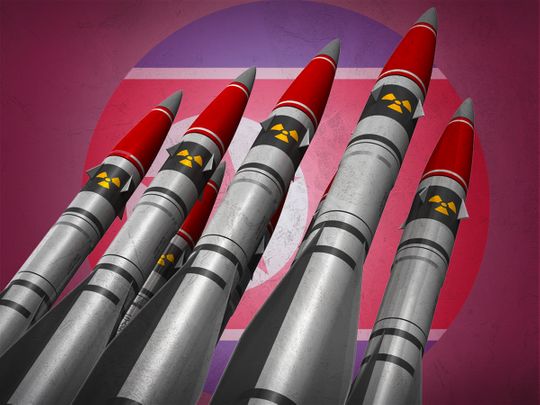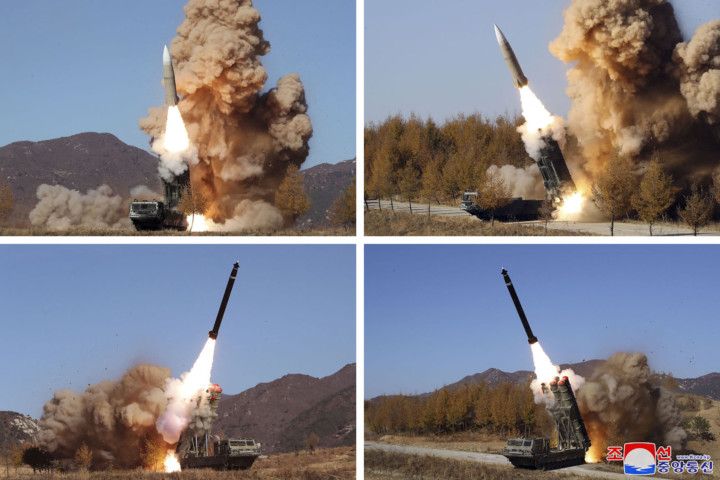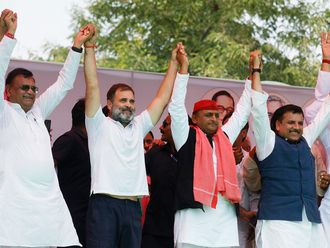
While much of the world was transfixed over the war in Ukraine, the Democratic Republic of Korea (DPRK) leader Kim Jong Un used the opportunity to test scores of ballistic missiles. His ultimate goal is clear —- to be able to launch the DPRK missiles to South Korea and the American military facilities in Asia — Pacific and into the mainland US.
For over two decades since DPRK conducted its intermediate range ballistic missile tests, the world has known its intention of developing nuclear tipped missiles that could target the US mainland.
During the last 12 months DPRK has tested submarine-launched ballistic missile, a train mounted ballistic missile, a new surface to air missile system, a long-range strategic cruise missile and several hypersonic missiles. The number of missiles launched has also increased progressively, according to Japan’s Ministry of Defence. Western sources indicate that DPRK is preparing its seventh nuclear test.
It is also evident that DPRK’s missile technology has considerably improved during the last 5-6 years. Forty per cent of these missiles since 2019 have variable trajectories, which makes them harder to shoot down.
Similarly, DPRK now increasingly uses solid fuel for missiles, avoiding extensive pre-launch preparations, making them harder to detect. Its range of nuclear capable missiles are able to evade South Korean and Japanese defence systems. The US too remains in suspense over these launches.
_resources1_16a4a163b07_original-ratio.jpg)
Despite all the UN sanctions for what the international community considers, its irresponsible behaviour, the DPRK has been successfully able to meander through the process of developing its missile technology.
The developments of these tactical-guided missiles with different ranges and solid fuel systems threaten South Korean capital, Seoul and Pyeongtaek area that hosts several US and South Korean military bases. Other missiles can hit Japan in areas where American military bases are located.
According to DPRK, demonstration of these advanced tactical weapons will prevent the US to intervene in any inter-Korea conflict or to think hard if it contemplates a direct military action against the DPRK. As they see it renunciation of nuclear weapons makes it vulnerable to invasions like in Iraq, Libya or Ukraine.
It is believed that DPRK has already built small nuclear weapons, which fit into missile launchers that can reach the US mainland. DPRK is also reported to have developed re-entry vehicles that can survive the intense heat and pressure of re-entering earth’s atmosphere.
It is now reportedly busy developing tactical nuclear weapons intended for use against targets like airports, defence installations, power facilities on the peninsula and US military bases in Japan.
The current spell of missile testing, according to the DPRK is in response to enhanced scale of joint military exercises, which US holds with South Korea every year. These exercises were suspended unilaterally by former President Donald Trump in 2018 when he launched his diplomatic engagement with the North Korean leader Kim Jong Un.
Expectedly, the size and scope of these exercises has expanded after Yoon Suk-yeol was elected president in South Korea year. The exercises are for preparing to launch an attack on the North, alleges DPRK.

In the wake of the current standoff the DPRK leader Kim Jong Un, in a speech to North Korea’s Supreme People’s Assembly on Sep. 8, declared the resolve to further develop the country’s nuclear and missile capabilities. The same day the Assembly passed a law allowing the right of pre-emptive nuclear strike for self-defence.
Kim Jong Un makes no secret of use of nuclear weapons if he believes a conventional attack in imminent against his country. This may well be a part of nuclear blackmail against South Korea and the US, extracting concessions from them.
DPRK’s development of nuclear weapons and its delivery systems could spark an arms race in the region. Within one-year Kim’s actions has increased public support for South Korea to go nuclear from 45 per cent to 55. If the South acquires nuclear weapons, it will spur Japan to follow suit and then China to augment its own nuclear capacity.
Why does the DPRK act the way it does? It is not an irrational state the way western media puts it. It is a paranoid state. Given the history of the region, their past wars with the South and the US intervention, Japanese occupation and the presence of American military bases all around, the DPRK feels insecure.
To overcome this insecurity, it is their strategy to demonstrate this belligerent posture and keep the adversaries guessing. Seoul is within their artillery range and with these missiles, they instill sufficient fear in their adversaries to prevent a pre-emptive attack.
They may never give up their deterrent. What DPRK needs is empathy, not threats.
Sajjad Ashraf served as an adjunct professor at the Lee Kuan Yew School of Public Policy, National University of Singapore from 2009 to 2017. He was a member of Pakistan Foreign Service from 1973 to 2008 and served as ambassador to several countries.









